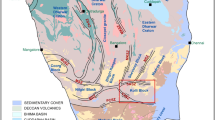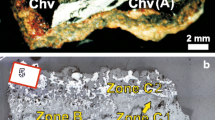Abstract
BIF with alkali amphibole at the Lebedinskoe iron deposits, the largest in Russia, were metamorphosed at 550°C and 2–3 kbar and contain ferriwinchite, riebeckite, actinolite, grunerite, and aegirine-augite. All reaction textures observed in the rocks were produced during the prograde metamorphic stage and represent the following succession of mineral replacements: Gru → Rbk, Act → Win → Rbk. Data obtained on the textural relations and compositional variations of Ca, Ca-Na, and Na Al-free amphiboles point to the complete miscibility in the actinolite-ferriwinchite and ferriwinchite-riebeckite isomorphic series. Riebeckite is formed in BIF during the prograde metamorphic stage, with the participation of a fluid insignificantly enriched in Na+ and at increasing oxygen fugacity. The critical factors controlling the development of alkali amphiboles and Ca-Na pyroxenes in carbonate-bearing BIF is the oxygen activity and the presence of at least low concentrations of Na+ ions in the fluid. The minerals contain Fe3+, and all reactions producing them are oxidation reactions. The origin of riebeckite late in the course of the mineral-forming process is caused by the Ca2+Mg2+ → Na+Fe3+ heterovalent isomorphic replacement in calcic and calcic-sodic amphiboles and by the oxidation of grunerite in the presence of a fluid enriched in Na ions.
Similar content being viewed by others
Abbreviations
- Gru :
-
grunerite
- Rbk :
-
riebeckite
- Act :
-
actinolite
- Win :
-
winchite
- Qtz :
-
quartz
- Mag :
-
magnetite
- Hem :
-
hematite
- Aeg :
-
aegirine
- Aug :
-
augite
- Aeg-Aug :
-
aegirine-augite
- Dol :
-
dolomite
- Cal :
-
calcite
- Di :
-
diopside
- Grt :
-
garnet
- Bt :
-
biotite
- Ap :
-
apatite
References
L. M. Anovitz and E. J. Essene, “Phase Equilibria in the System CaCO3-MgCO3-FeCO3,” J. Petrol. 28, Pt. 2, 389–414 (1987).
G. V. Artemenko, Doctoral Dissertation in Geology and Mineralogy (Kiev, 1998) [in Russian].
M. Cameron and J. J. Papike, “Structural and Chemical Variations in Pyroxenes,” Am. Mineral. 66(1/2), 1–50 (1981).
H. P. Eugster, “Inorganic Bedded Cherts from the Magadi Area, Kenya,” Contrib. Mineral. Petrol. 22, 1–31 (1969).
V. I. Fonarev, A. A. Graphchikov, and A. N. Konilov, “A Consistent System of Geothermometers for Metamorphic Complexes,” Int. Geol. Rev. 33(8), 743–783 (1991).
B. M. French, “Mineral Assemblages in Diagenetic and Low-Grade Metamorphic Iron Formations,” Econ. Geol. 68, 1063–1074 (1973).
J. Ganguly and S. K. Saxena, “Mixing Properties of Aluminosilicate Garnets: Constraints from Natural and Experimental Data, and Applications to Geothermobarometry,” Am. Mineral. 69(1/2), 88–97 (1984).
S. Ghose, W. C. Forbes, and P. P. Phakey, “Unmixing of an Alkali Amphibole (Tirodite) Into Magnesio-Richerite and Magnesio-Riebeckite,” Indian J. Earth Sci., No. 1, 37–42 (1974).
S. Giralt, S. Riera, J. Klerkx, et al., “Lake Issyk-Kul: An Example of Recent Evolution in a Continental Environment,” in Proceedings of 3rd Workshop Southern European Working Group of the European Lake Drilling, Girona, Spain, 2001, Terra Nostra, No. 1/2, 30–36 (2001).
A. A. Glagolev, Metamorphism of the Precambrian Rocks of KMA (Nauka, Moscow, 1966) [in Russian].
M. J. Gole and C. Klein, “Banded Iron Formation through Much of Precambrian Time,” J. Geol. 89, 169–183 (1981).
K. V. Hodges and F. S. Spear, “Geothermometry, Geobarometry and the Al2SiO5 Triple Point at Mt. Moosilauke, New Hampshire,” Am. Mineral. 67(11/12), 1118–1134 (1982).
M. J. Holdaway and S. M. Lee, “Fe-Mg Cordierite Stability in High Grade Pelitic Rocks, Based on Experimental, Theoretical and Natural Observations,” Contrib. Mineral. Petrol. 63(2), 175–198 (1977).
Iron Ores of KMA, Ed. by V. P. Orlov et al. (Geoinformark, Moscow, 2001) [in Russian].
H. L. James, “Sedimentary Facies of Iron Formation,” Econ. Geol. 49, 235–285 (1954).
C. Klein, “Greenalite, Minnesotaite, Crocidolite and Carbonates in a Very Low-Grade Metamorphic Precambrian Iron Formation,” Can. Mineral. 12, 475–498 (1974).
C. Klein, “Two-Amphibole Assemblages in the System Actinolite-Hornblende-Glaucophane,” Am. Mineral. 54, 212–237 (1969).
C. Klein, “Diagenesis and Metamorphism of Precambrian Iron Formations,” in Iron Formations: Facts and Problems, Ed. by A. F. Trendall and R. C. Morris (Elsevier, Amsterdam, 1983), pp. 417–469.
I. V. Lavrent’eva and L. L. Perchuk, “Phase Relations in the Biotite-Garnet System. Experimental Data,” Dokl. Akad. Nauk SSSR 260(3), 731–734 (1981).
B. E. Leake and A. R. Woolley, and 20 Members of the Subcommittee on Amphiboles, “Nomenclature of Amphiboles. Report of the Subcommittee on Amphiboles of the International Mineralogical Association Commission on New Minerals and Mineral Names,” Eur. J. Mineral 9, 623–651 (1997).
C. M. Lesher, “MIneralogy and Petrology of the Sokoman Iron Formation Near Ardua Lake, Quebec,” Can. J. Earth Sci. 15, 480–500 (1978).
T. Miyano and C. Klein, “Conditions of Riebeckite Formation in the Iron-Formation of the Dales Gorge Member, Hamersley Group, Western Australia,” Am. Mineral. 68, 517–529 (1983).
T. Miyano and N. J. Beukes, “Mineralogy and Petrology of the Contact Metamorphosed Amphibole Asbestos-Bearing Penge Iron Formation, Eastern Transvaal, South Africa,” J. Petrol. 38(5), 651–676 (1997).
T. Miyano, “Stilpnomelane, Fe-Rich Mica, K-Feldspar and Hornblende in Banded Iron Formation Assemblages of the Dales Gorge Member, Hamersley Group, Western Australia,” Can. Mineral. 20, 189–202 (1982).
N. Morimoto, “Nomenclature of Pyroxenes. Report of the Subcommittee on Pyroxenes of the International Mineralogical Associations on New Minerals and Mineral Names,” Can. Mineral. 27, 143–156 (1989).
T. Oba and I. A. Nicholls, “Experimental Study of Cummingtonite and Ca-Na Amphibole Relations in the System Gru-Act-Pl-Qtz-H2O,” Am. Mineral. 71, 1354–1365 (1986).
B. E. Patric and B. W. Evans, “Metamorphic Evolution of the Seward Peninsula Blueschist Terrane,” J. Petrol. 30(3), 531–555 (1989).
L. L. Perchuk, “Consistency between Some Fe-Mg Geothermometer based on the Nernst Law: Revision,” Geokhimiya, No. 5, 611–622 (1989).
N. A. Plaksenko, Principal Relations and Tendencies of Iron Sedimentation in the Precambrian (Voronezhsk. Univ., Voronezh, 1966) [in Russian].
D. Puhan, Petrographie und Geothermometrische Untersuchungen an Silicat Fuhrenden Dolomit-Calcit-Marmoren zur Ermittlung den Metamorphose Bedingungen im Zentral-Damara-Orogen (SW-Africa) (Univ. Gottingen, Habil, 1979).
B. Reynard and M. Ballevre, “Coexisting Amphiboles in an Eclogite from the Western Alps: New Constraints on the Miscibility Gap Between Sodic and Calcic Amphiboles,” J. Metamorph. Geol. 6, 333–350 (1988).
P. Robinson, F. S. Spear, J. C. Schumacher, et al., “Phase Relations of Metamorphic Amphiboles: Natural Occurrence and Theory,” Rev. Mineral. 9B, 1–201 (1982).
K. A. Savko and M. V. Poskryakova, “Mineralogy, Phase Equilibria, and Metamorphism of the Rocks of the Novoyaltinskoe Iron Deposit of KMA,” Vestn. Voronezhsk. Univ., Ser. Geol., No. 2, 113–130 (2003a).
K. A. Savko and M. V. Poskryakova, “Mineralogy, Phase Equilibria, and Metamorphism of the Shemraevskoe Iron Deposit of the Kursk Magnetic Anomaly,” Vestn. Voronezhsk. Univ., Ser. Geol., No. 1, 68–84 (2004).
K. A. Savko and M. V. Poskryakova, “Riebeckite-Aegirine-Celadonite BIF at the Mikhailovskoe Iron Deposit of the Kursk Magnetic Anomaly: Phase Equilibria and Metamorphic Conditions,” Petrologiya 11, 471–490 (2003b) [Petrology 11, 426–443 (2003)].
K. A. Savko and N. Yu. Kal’mutskaya, “Physicochemical Conditions of Metamorphism of the Magnetite-Grunerite-Riebeckite Rocks of the Prioskol’skoe Iron Deposit of the Kursk Magnetic Anomaly,” Vestn. Voronezhsk. Univ., Ser. Geol., No. 1, 95–103 (2002).
I. N. Shchegolev, Precambrian Ore Deposits and Methods of their Study (Nedra, Moscow, 1985) [in Russian].
N. P. Shcherbak, G. V. Artemenko, E. N. Bartnitskii, et al., “Age of Silicic Metavolcanic Rocks of the Aleksandrovskii and Korobkovskii Areas of KMA,” Dokl. Akad. Nauk Ukr. SSR: Ser. B, No. 6, 120–123 (1992).
C. K. Shearer, J. C. Schumacher, and P. Robinson, “Zoned Hastingsite-Ferri-Katophorite-Taramite Phenocrysts, an Amphibole + Orthoclase = Aegirine-Augite + Biotite Reaction, and a New Sodic Amphibole in Nepheline-Sodalite Syenite, Red Hill, New Hampshire,” Geol. Soc. Amer. Abstr. 13, 552 (1981).
E. A. Smelik and D. R. Veblen, “Exsolution of Ca-Amphibole from Glaucophane and the Miscibility Gap Between Sodic and Calcic Amphiboles,” Contrib. Mineral. Petrol. 112, 178–195 (1992).
A. S. Talantsev, Geothermobarometry on Dolomite-Calcite Assemblages (Nauka, Moscow, 1981) [in Russian].
A. B. Thompson, “Mineral Reactions in Pelitic Rocks: 1. Prediction of P-T-X (Fe-Mg) Relations,” Am. J. Sci. 276(4), 401–424 (1976).
A. F. Trendall and J. G. Blockley, “The Iron Formation of the Precambrian Hamersley Group, Western Australia with Special Reference to the Associated Crocidolite,” Geol. Surv. W. Aust. Bull. (1970).
Author information
Authors and Affiliations
Additional information
Original Russian Text © K.A. Savko, 2006, published in Petrologiya, 2006, Vol. 14, No. 6, pp. 604–625.
Rights and permissions
About this article
Cite this article
Savko, K.A. Phase equilibria in rocks of the paleoproterozoic banded iron formation (BIF) of the Lebedinskoe deposit, Kursk Magnetic Anomaly, and the petrogenesis of BIF with alkali amphiboles. Petrology 14, 567–587 (2006). https://doi.org/10.1134/S086959110606004X
Received:
Issue Date:
DOI: https://doi.org/10.1134/S086959110606004X




